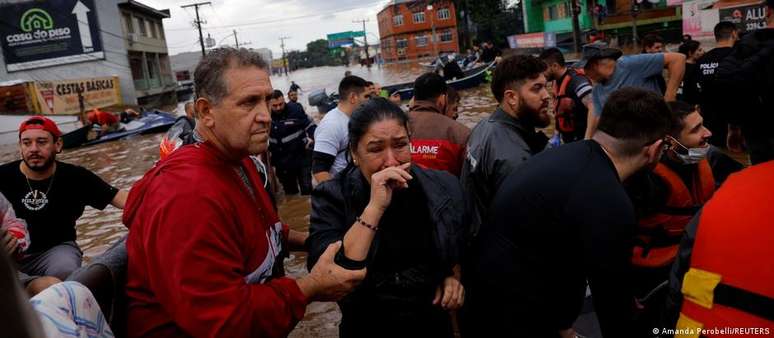Family members and volunteers mobilize to search for missing people and save people stranded by the floods. So far, more than 780,000 people have been affected. From Brasilia, Claudia Lisboa helps her son-in-law locate her great-aunt, Maria Amenaide Freitas Maldini, a resident of Guaíba, in Rio Grande do Sul, a state devastated by floods. This Sunday (05/04), 24 hours passed without the family having heard from the 84-year-old woman, who takes medication and is deaf.
“She was with her caregiver at the time of the rescue, but they left her dog, Obama, behind. The caregiver went to one place and she went to another. Let’s assume she came back [para casa] take the dog,” Lisbon tells DW.
Regina Oliveira has spent the last two days searching for her father, Pedro Paulo Terres da Silva, 93, who disappeared in Canoas. From Novo Hamburgo, about 30 kilometers away, Silva’s family is looking for information and mobilizing whoever they can, as the bridges connecting the two cities are closed due to floods.
Silva’s house had never been flooded before, but the level of the Sinos River in Canoas reached a record high and flooded entire neighborhoods. Moments before the end of this report, his name was listed as a person rescued and housed in a shelter, to the relief of his family.
In the city, the Civil Protection uses all possible channels to ask residents to evacuate and take their pets with them when they flee. Powerless in the face of the catastrophe, the municipality asks for help from volunteers who have boats to remove the stranded people.
Friends of journalist Eduardo Grassi try to get to Canoas with a motor boat in their car. They left Sunday morning from Chapecó, in Santa Catarina, more than 450 kilometers away, and continued their journey without knowing if they would be able to reach it.
Waiting for help
There are numerous calls for help coming from various flooded cities.
From the capital Porto Alegre, Renata Rodrigues seeks help for the elderly couple Jane de Fátima Mattos da Silva and Charles Wilson Tavares da Silva. They are in Farrapos, a humble neighborhood on the banks of the Jacuí River, and they say the water reached the second floor of the house.
“They are family members of my colleague. We are part of a task force not only for them, but for several people in the region. We took away around 150 people,” Rodrigues told DW.
The neighborhood where he lives, Bom Fim, was not affected by the flood, but the house has become a refuge for friends who have lost everything. “Right now I’m getting ready to go to the shelter I’m helping organize to see what we’re going to do today,” Rodrigues says.
In Eldorado do Sul, a couple and two children use their cell phone’s remaining battery to send calls for help. Bruna Karpinski is their friend and she hopes they will be rescued soon, she tells DW.
In addition to official operations in the affected locations, countless volunteers are being mobilized. A group of geographer friends created an online map that organizes the ransom demands. There are more than a hundred points that have the address and how many people are waiting for help. The data is sent to other volunteers who have a boat or jet ski, as well as being available to the authorities.
Lists with the names of people waiting to travel on closed roads are circulating in local messaging groups. Others search for names of acquaintances in a list of bodies pulled from the water and rubble.
Installed tragedy
The National Civil Protection estimates that there are at least 2,500 ransom requests. According to the agency’s latest bulletin, 336 affected municipalities in the state are affected by the extreme rainfall. There are more than 88 thousand homeless people, temporarily hosted by friends or relatives, and over 16.6 thousand are in temporary accommodation organized by public authorities.
To date, 77 deaths have been confirmed and 108 people missing. In total, it is estimated that more than 780 thousand residents in Rio Grande do Sul have been affected.
The local utility reported that as of Sunday morning, there were 421,000 homes without electricity. Most have been disconnected from the grid for safety reasons due to flooded areas.
Dam monitoring carried out by the federal and Rio Grande do Sul governments indicates that six structures are in an emergency situation, at risk of collapse. The bulletin released this Sunday states that containment actions are underway. The most serious cases, with risk of imminent failure, are the 14 de Julho hydroelectric power plant, in Cotiporã and Bento Gonçalves, and Salto Forqueta, in São José do Herval/Putinga.
Forecast for the next few days
The Brazilian Geological Survey (SGB) says that there is still a lot of water in the Jacuí and Taquari rivers, in the direction of Porto Alegre. The level in Guaíba, therefore, should continue to rise: on Sunday it was 5.28 meters. The experience recorded in 1941, the last worst flood until then, showed that the river level took two weeks to return to normal.
It is still raining in the Guaíba river basin. Strong bangs were recorded in some parts of the river last morning, the SGB reported.
Marcelo Seluchi, coordinator of the National Center for Monitoring and Warning of Natural Disasters (Cemaden), told DW that the rains were expected to concentrate in Uruguay in the coming days. “From Thursday and Friday it should start raining again in the region, sometimes swinging more northwards, sometimes southwards,” Seluchi predicts based on the models.
Little precipitation is expected over the next 72 hours. The hydrological situation and water movement will remain critical in Grande Porto Alegre.
Source: Terra
Rose James is a Gossipify movie and series reviewer known for her in-depth analysis and unique perspective on the latest releases. With a background in film studies, she provides engaging and informative reviews, and keeps readers up to date with industry trends and emerging talents.





